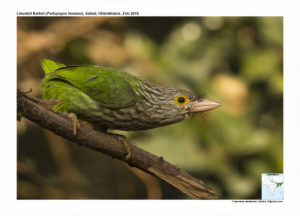Lineated Barbet

Lineated Barbet Megalaima lineata
Etymology:
-
- Megalaima: Greek word megalos- great; laimos- throat. { Great Throat}
- Lineata: Latin word for “Marked with lines” derived from linea line
Vernacular Names: U.P: Bada basanta, Kotur, Lepcha: Dang kun nyong, Cachar: Dao tukra, Naga: Inruikuru, Nepal: Kudurta, Khotoor, Hindi: Dharidar Basanta
They are tree dwelling fruit eating birds. They get their name from the bristles which fringe their heavy bills
Distribution in India: Resident Himalayan foothills, North East of India.
Description: Size of 25–30 cm; wt. of 115–205 g. Large, green and streaky Barbet; individual variation in intensity of coloration. Both sexes of nominate race are heavily streaked on head, upper mantle and breast, whitish streaks broader than dark brown ones. The throat and chin tend to be whitish; rest of plumage is green; bill is yellow, pink or horn, becoming creamy pink with yellow base when breeding. It has yellow or gold skin around eye; legs are yellow. The immature are duller, buffier
Habitat: It is found in Evergreen forest, especially at clearings and edges, also pine forest, teak, sal and deciduous forest.
Food Habits: They eat figs and other fruits, and berries, also flowers of pistachio. They also eat nectar. It also eats larvae of various insects, termites; also frogs, nestling birds and bird eggs. It congregates at fruiting trees with other Barbets.
Breeding Habits: They breed in Jan–Jul in most areas; Sept–May in Malay Peninsula; Jan–Jul and Sept–Oct in Java and Bali. . They sing much of year. When in aggression birds droop wings, gape and call. Both adults excavate nest-hole in a dead tree or branch, even standing log, or stump, above ground. They lay a clutch of 2–4 eggs. Both the parents incubate, both feed young. The incubation period is 14–15 days.